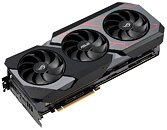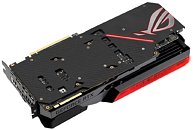Raevenlord
News Editor
- Joined
- Aug 12, 2016
- Messages
- 3,755 (1.21/day)
- Location
- Portugal
| System Name | The Ryzening |
|---|---|
| Processor | AMD Ryzen 9 5900X |
| Motherboard | MSI X570 MAG TOMAHAWK |
| Cooling | Lian Li Galahad 360mm AIO |
| Memory | 32 GB G.Skill Trident Z F4-3733 (4x 8 GB) |
| Video Card(s) | Gigabyte RTX 3070 Ti |
| Storage | Boot: Transcend MTE220S 2TB, Kintson A2000 1TB, Seagate Firewolf Pro 14 TB |
| Display(s) | Acer Nitro VG270UP (1440p 144 Hz IPS) |
| Case | Lian Li O11DX Dynamic White |
| Audio Device(s) | iFi Audio Zen DAC |
| Power Supply | Seasonic Focus+ 750 W |
| Mouse | Cooler Master Masterkeys Lite L |
| Keyboard | Cooler Master Masterkeys Lite L |
| Software | Windows 10 x64 |
ASUS is looking to one-up the competition in the flagship graphics card market with its ROG MATRIX rendition of the RTX 2080 Ti interpretatioin of NVIDIA's silicon. The ROG MATRIX GeForce RTX 2080 Ti will incorporate an AIO watercooling solution complete with waterblock, pump, radiator and fans in a triple-slot design. ASUS claims the Infinity Loop cooler will bring about performance equivalent of that of an external 240mm AIO - a bold claim, since physics and proximity of the radiator and fans themselves to the PCB and die should dictate a higher temperature than an otherwise completely external solution.
That said, the design of the Infinity Loop is likely one of the most interesting graphics card cooling designs in some time, with a completely self-contained solution. The shroud and side of the graphics card feature laser cutouts and LED-illuminated elements (because 2019 wouldn't be much different from 2018 in that regard). Out-of-the-box clocks are set at 1815 MHz before any additional overclocking, and the card takes power from 2x 8-pin power connectors. The cost? North of $1600. Now that's design, even in the price-tag.



View at TechPowerUp Main Site
That said, the design of the Infinity Loop is likely one of the most interesting graphics card cooling designs in some time, with a completely self-contained solution. The shroud and side of the graphics card feature laser cutouts and LED-illuminated elements (because 2019 wouldn't be much different from 2018 in that regard). Out-of-the-box clocks are set at 1815 MHz before any additional overclocking, and the card takes power from 2x 8-pin power connectors. The cost? North of $1600. Now that's design, even in the price-tag.



View at TechPowerUp Main Site










 .
.